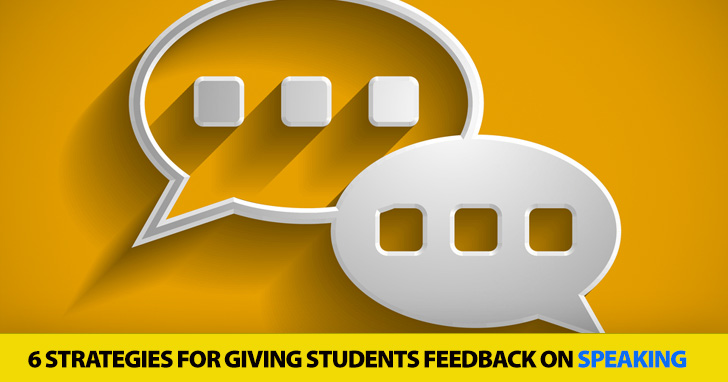Tuning in the Feedback: 6 Strategies for Giving Students Feedback on Speaking


The teacher gives information. The student makes it a part of their knowledge base. The teacher corrects mistakes and gives feedback. But what if we could turn this standard on its head? What if students could discover truth for themselves? If teachers could guide their students to discovery and insight? What if students could correct their own mistakes? Believe it or not, this is possible. It just requires some thinking outside the traditional education box. And when it does happen, hold on to your hats! Students learn better and English becomes a piece of who they are rather than a tool they use when necessary. You may not be ready to turn the whole system on its head, but that doesn’t mean you can’t start small. Try these simple tips for helping students help themselves.
Grammar exercises are a standard part of language instruction. We do them all the time for just about every grammar point we teach. You can encourage students to learn independently by putting a spin on exercises you normally use. Try giving your students the exercise BEFORE you teach the grammar concept. Of course they won’t be able to fill in the blanks or rewrite the sentences. That’s why you give them the answers as well.
Have your students take a close look at the questions as well as the answers and challenge them to figure out the grammar rule on their own. For example, say you have an exercise on forming the simple past of regular verbs. Give your students the questions and the answers. Odds are your students will see the addition of –ed to the verbs to express the past. When they do, they will have figured out the grammar rule on their own, and that will help them remember it better.
This strategy works with more than just beginning level grammar. You can teach nearly any regular grammatical pattern this way including verb tenses, conditionals, comparative and superlative adjectives…just about anything. Just don’t expect students to find a rule for irregular past tense verbs and other forms that don’t follow the standard.
Students in ESL writing classes can become very dependent on their teachers and classmates for editing and proofreading. It is always easier for someone else to find your mistakes than for you to find them yourself. (Believe me, I know from experience.) But just giving the corrections to your students doesn’t really help them learn to find mistakes on their own. Here is a method you can use to teach students to find their own mistakes in their writing.
Have students write a short piece – a paragraph or two is plenty the first time you give feedback this way. Collect the paragraphs and proofread them for mistakes. But rather than marking the mistakes on their paper or even using editing marks in all the right places, make a list of errors on a separate sheet of paper. Don’t write down the exact mistakes but rather the types of mistakes you see in the paper, and write them in order. So you might start a list for your students like this: subject/verb agreement, spelling error, incorrect plural form, etc. (If it’s easier, use proofreading marks when writing your list.) When you encounter another mistake of the same type, rather than listing it in order, put a check mark next to that category where it already is on your list. Continue until you have noted each type of error in the paper and the number of times it occurs. Then give your students their paper as well as your list.
Students must then go through their paper and find the errors you listed. At first, it won’t be too tough since the errors will be in order on your list and in their paragraphs, but it will get tougher as they go along. As students correct the errors, they should highlight them on your list. Students should continue to make the corrections and look for their own errors, marking them off the list as they find them.
Through the process, your students will learn to look for mistakes in their own writing. The more you give them feedback in this way, the fewer mistakes they will make in subsequent writing assignments. More importantly, though, they will be learning a valuable skill. Proofreading their own writing. And though it might be a bigger time investment for you the first few times you give feedback this way, eventually your students will make fewer mistakes and will be correcting their own as they write. At that point, it will take you less time to give feedback.
I’m not talking about the fire alarm; I’m talking about the record button. Human beings have a tendency to see and hear what we want to. That is true from how we look in bathing suits to believing what others say about us even when it’s not true. It also includes pronunciation in a foreign language. No one likes to hear themselves recorded. We all sound different in our own heads than we do on a recording, but making your students listen to themselves as they speak English is a wakeup call in a good way.
Sometimes students think they are pronouncing things in one way or speaking with fluency when they aren’t. Reality is different than their self-perception. Make it a regular practice to record your students as they speak. If nothing else, use an audio recorder. But video recorders come standard with our phones these days, so it should be no problem to video student presentations, role-plays, and/or discussions. Record each student regularly, and then have them review the recordings.
You can get a video of everyone in class over different days and then give class time to review the recordings, or you can email your recordings to your students and have them review them for homework. Challenge your students to listen carefully for lack of fluency, pronunciation mistakes, grammatical errors, and pauses in their speech. Have students write down what they hear. Also encourage them to write down their strengths when it comes to their spoken English. Then have students give themselves a speaking grade and see if it matches the grade you would have given them on the same recording. You can discuss your findings one on one, which will also give each person in class some individual speaking time with you.
Use these strategies to help students help themselves, and you will be amazed at what great instructors they can be to themselves.